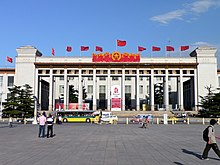Tiananmen Square
Tiananmen Square or Tian'anmen Square (/ˈtjɛnənmən/[1]) is a city square in the city center of Beijing, China, named after the eponymous Tiananmen ("Gate of Heavenly Peace") located to its north, which separates it from the Forbidden City. The square contains the Monument to the People's Heroes, the Great Hall of the People, the National Museum of China, and the Mausoleum of Mao Zedong. Mao Zedong proclaimed the founding of the People's Republic of China in the square on October 1, 1949; the anniversary of this event is still observed there.[2] The size of Tiananmen Square is 765 x 282 meters (215,730 m2 or 53.31 acres).[3] It has great cultural significance as it was the site of several important events in Chinese history.
This article is about the city square. For the historical event, see 1989 Tiananmen Square protests and massacre.Tiananmen Square
Tiān'ānmén Guǎngchǎng
Tiān'ānmén Guǎngchǎng
Tiān'ānmén Guǎngchǎng
ㄊㄧㄢ ㄢ ㄇㄣˊ
ㄍㄨㄤˇ ㄔㄤˇ
Tian'anmen Goangchaang
Tʻien1-an1-mên2 Kuang3-chʻang3
Thie-oe-men Kuaon-zan
Tīn'ōnmùhn Gwóngchèuhnḡ
Tin1on1mun4 Gwong2coeng4
Thian-an-mn̂g Kóng-tiûⁿ
ᡝᠯᡥᡝ ᠣᠪᡠᡵᡝ ᡩᡠᡴᠠ
elhe obure duka
Outside China, the square is best known for the 1989 protests and massacre that ended with a military crackdown due to international media coverage, internet and global connectivity, its political implications, and other factors.[4][5][6] Within China, little, if anything about the massacre is known by most Chinese due to strict censorship of knowledge of the crackdowns by the Chinese Communist Party.[7]











